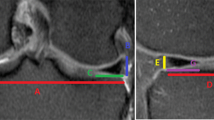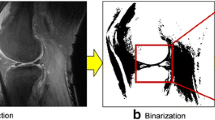Abstract
Purpose
The objectives of this study were to assess the influence of weight-bearing on tibiofemoral osteoarthritis, including medial meniscal extrusion, by using a low-field (0.25 T) rotating clino-orthostatic permanent-magnet magnetic resonance (MR) scanner, and to analyse correlations of medial meniscal extrusion with the patient’s Kellgren–Lawrence score, body mass index, and all the osteoarthritis features of the WORMS scoring system.
Materials and methods
Twenty-six patients (69.2 % women and 30.8 % men; mean age 67 ± 9.7 years) with medial tibiofemoral knee osteoarthritis were prospectively enrolled and MR sequences were acquired in both clino- and orthostatic position. MR images were assessed by two independent radiologists, according to the WORMS scale. Medial meniscal extrusion was measured and its clino-orthostatic difference (∆MME) was calculated.
Results
Intra- and inter-observer agreement of the WORMS Global Score readings was high by Cohen’s K test (>0.81). No significant clino-orthostatic changes in the scoring parameters of the medial tibiofemoral joint were shown by Wilcoxon’s test. Medial meniscal extrusion measured on orthostatic images was significantly higher than that measured in clinostatic position (p < 0.0001). At univariate analysis, the Kellgren-Lawrence score, WORMS Global Score, cartilage loss, meniscal damage, and osteophytes were significantly correlated to ∆MME (p < 0.005). Using a multiple regression model, tibiofemoral cartilage loss was found to correlate independently with ∆MME (p = 0.0499).
Conclusions
Medial meniscal extrusion, evaluated with an open-configuration, rotating MR scanner, increased from the clinostatic to the orthostatic position. ∆MME, a new meniscal parameter, correlated with several important features of medial tibiofemoral osteoarthritis.





Similar content being viewed by others
References
Crema MD, Guermazi A, Li L et al (2010) The association of prevalent medial meniscal pathology with cartilage loss in the medial TF compartment over a 2-year period. Osteoarthr Cartil 18:336–343
Hunter DJ, Zhang YQ, Niu JB et al (2006) The association of meniscal pathologic changes with cartilage loss in symptomatic knee osteoarthritis. Arthritis Rheum 54:795–801
Crema MD, Roemer FW, Felson DT et al (2012) Factors associated with meniscal extrusion in knees with or at risk for osteoarthritis: the Multicenter Osteoarthritis study. Radiology 264:494–503
Wang Y, Wluka AE, Pelletier JP et al (2010) Meniscal extrusion predicts increases in subchondral bone marrow lesions and bone cysts and expansion of subchondral bone in osteoarthritic knees. Rheumatology 49:997–1004
Berthiaume MJ, Raynauld JP, Martel-Pelletier J et al (2005) Meniscal tear and extrusion are strongly associated with progression of symptomatic knee osteoarthritis as assessed by quantitative magnetic resonance imaging. Ann Rheum Dis 64:556–563
Englund M, Guermazi A, Roemer FW et al (2009) Meniscal tear in knees without surgery and the development of radiographic osteoarthritis among middle-aged and elderly persons: the Multicenter Osteoarthritis Study. Arthritis Rheum 60:831–839
Sharma L, Eckstein F, Song J et al (2008) Relationship of meniscal damage, meniscal extrusion, malalignment, and joint laxity to subsequent cartilage loss in osteoarthritic knees. Arthritis Rheum 58:1716–1726
Le Graverand MP, Vignon EP, Brandt KD et al (2008) Head-to-head comparison of the Lyon Schuss and fixed flexion radiographic techniques. Long-term reproducibility in normal knees and sensitivity to change in osteoarthritic knees. Ann Rheum Dis 67:1562–1566
Buckland-Wright JC, Macfarlane DG, Lynch JA et al (1995) Joint space width measures cartilage thickness in osteoarthritis of the knee: high resolution plain film and double contrast macroradiographic investigation. Ann Rheum Dis 54:263–268
Adams JG, McAlindon T, Dimasi M et al (1999) Contribution of meniscal extrusion and cartilage loss to joint space narrowing in osteoarthritis. Clin Radiol 54:502–506
Schiphof D, de Klerk BM, Kerkhof HJ et al (2011) Impact of different descriptions of the Kellgren and Lawrence classification criteria on the diagnosis of knee osteoarthritis. Ann Rheum Dis 70:1422–1427
Stehling C, Souza RB, Hellio Le Graverand MP et al (2012) Loading of the knee during 3.0T MRI is associated with significantly increased medial meniscus extrusion in mild and moderate osteoarthritis. Eur J Radiol 81:1839–1845
Altman R, Asch E, Bloch D et al (1986) Development of criteria for the classification and reporting of osteoarthritis. Classification of osteoarthritis of the knee. Diagnostic and therapeutic criteria committee of the American rheumatism association. Arthritis Rheum 29:1039–1049
Kellgren JH, Lawrence JS (1957) Radiological assessment of osteo-arthrosis. Ann Rheum Dis 16:494–502
Mauch F, Jung C, Huth J, Bauer G (2010) Changes in the lumbar spine of athletes from supine to the true-standing position in magnetic resonance imaging. Spine 35:1002–1007
Peterfy CG, Guermazi A, Zaim S et al (2004) Whole-organ magnetic resonance imaging score (WORMS) of the knee in osteoarthritis. Osteoarthr Cartil 12:177–190
Roemer FW, Lynch JA, Niu J et al (2010) A comparison of dedicated 1.0 T extremity MRI vs large-bore 1.5 T MRI for semiquantitative whole organ assessment of osteoarthritis: the MOST study. Osteoarthr Cartil 18:168–174
Kladny B, Gluckert K, Swoboda B et al (1995) Comparison of low-field (0.2 Tesla) and high-field (1.5 Tesla) magnetic resonance imaging of the knee joint. Arch Orthop Trauma Surg 114:281–286
De Smet AA, Tuite MJ (2006) Use of the “two-slice-touch” rule for the MRI diagnosis of meniscal tears. AJR Am J Roentgenol 187:911–914
Gale DR, Chaisson CE, Totterman SM et al (1999) Meniscal subluxation: association with osteoarthritis and joint space narrowing. Osteoarthr Cartil 7:526–532
Fleiss JL (1986) The design and analysis of clinical experiments. Wiley, New York
Vedi V, Williams A, Tennant SJ et al (1999) Meniscal movement: an in vivo study using dynamic MRI. J Bone Jt Surg Br 81:37–41
Boxheimer L, Lutz AM, Treiber K et al (2004) MR imaging of the knee: position related changes of the menisci in asymptomatic volunteers. Invest Radiol 39:254–263
Boxheimer L, Lutz AM, Zanetti M et al (2006) Characteristics of displaceable and nondisplaceable meniscal tears at kinematic MR imaging of the knee. Radiology 238:221–231
Seedhom BB, Dowson D, Wright V (1974) Proceedings: functions of the menisci—a preliminary study. Ann Rheum Dis 33:111
Walker PS, Erkman MJ (1975) The role of the menisci in force transmission across the knee. Clin Orthop Relat Res 109:184–192
Costa CR, Morrison WB, Carrino JA (2004) Medial meniscus extrusion on knee MRI: is extent associated with severity of degeneration or type of tear? AJR Am J Roentgenol 183:17–23
Zanetti M, Bruder E, Romero J, Hodler J (2000) Bone marrow edema pattern in osteoarthritic knees: correlation between MR imaging and histologic findings. Radiology 215:835–840
Raynauld JP, Martel-Pelletier J, Berthiaume MJ et al (2008) Correlation between bone lesion changes and cartilage volume loss in patients with osteoarthritis of the knee as assessed by quantitative magnetic resonance imaging over a 24-month period. Ann Rheum Dis 67:683–688
Felson DT, McLaughlin S, Goggins J et al (2003) Bone marrow edema and its relation to progression of knee osteoarthritis. Ann Intern Med 139:330–336
Conflict of interest
The Authors declare no conflict of interest.
Author information
Authors and Affiliations
Corresponding author
Rights and permissions
About this article
Cite this article
Paparo, F., Revelli, M., Piccazzo, R. et al. Extrusion of the medial meniscus in knee osteoarthritis assessed with a rotating clino-orthostatic permanent-magnet MRI scanner. Radiol med 120, 329–337 (2015). https://doi.org/10.1007/s11547-014-0444-6
Received:
Accepted:
Published:
Issue Date:
DOI: https://doi.org/10.1007/s11547-014-0444-6




